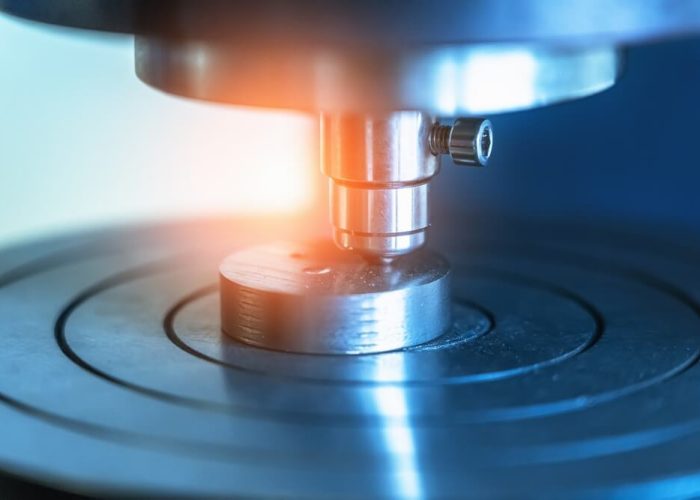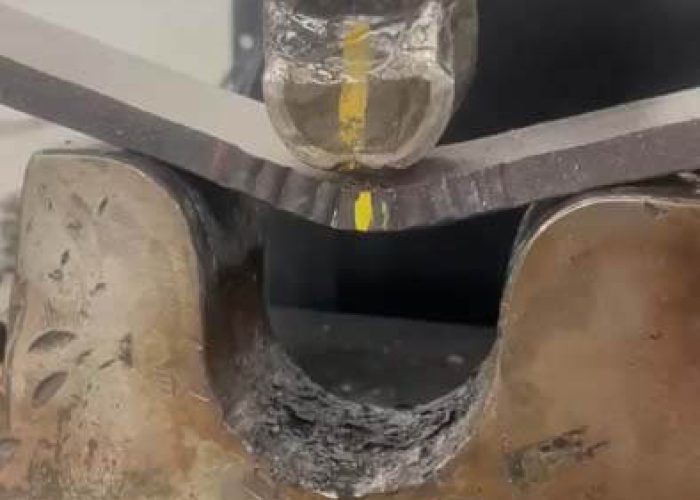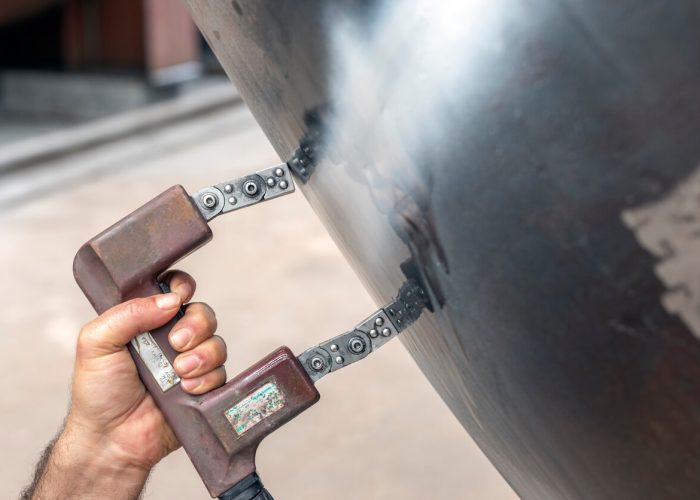Industrial Welding Services
Industrial welding services encompass different techniques like MIG, TIG, arc, and resistance welding, each suited for specific applications. We use necessary equipment such as welding machines, manipulators, and positioners to ensure precision and efficiency. Safety is paramount, requiring proper training, protective gear, and ventilation systems. In manufacturing and construction, we apply these methods for tasks ranging from high-speed production to heavy-duty fabrication. Modern advancements have greatly improved welding technology, enhancing both productivity and safety. As we continue to innovate, experienced welders remain vital for executing complex projects with unparalleled accuracy. Exploring further reveals the intricate world of industrial welding techniques and their extensive impacts.

Key Points
- Industrial welding encompasses various techniques like MIG, TIG, and arc welding for joining metals in manufacturing and construction.
- Essential equipment includes welding machines, manipulators, and positioners to ensure precision and efficiency in industrial projects.
- Safety measures, including proper training, protective gear, and ventilation systems, are crucial in industrial welding environments.
- Welding applications span multiple industries, from automotive manufacturing to heavy machinery fabrication and infrastructure development.
- Advancements in welding technology, such as laser and electron beam welding, continue to improve precision, speed, and quality in industrial settings.
Types of Industrial Welding Techniques
Industrial welding encompasses five primary techniques that are widely utilized in manufacturing and construction. Let’s explore these methods that we, as welding professionals, commonly employ in our field.
MIG welding, a type of gas metal arc welding, is one of our go-to techniques. We use an electric arc between the metal and electrode to melt and fuse various alloys. It’s a versatile method that we often rely on for its efficiency and adaptability. Additionally, we confirm all testing is performed in accordance with AWS, ASME, ASTM, and/or other pertinent specifications.
Gas welding is another technique we frequently use, especially for maintenance work. We appreciate its slower cooling process compared to arc welding, which can be advantageous in certain situations.
Arc welding is a fundamental technique in our industry. We use it extensively for repair works and fabricating steel structures, thanks to its constant current source.
TIG welding, a subtype of gas tungsten arc brazing, is our choice for high-quality welds. We utilize a tungsten electrode to achieve superior finishes on various metals.
Lastly, we employ resistance welding for mass production, particularly in automobile manufacturing. It’s an efficient method where we press metal pieces between electrodes to create intense heat for spot welds.
Essential Welding Equipment
Invariably, our welding operations rely on a core set of essential equipment to guarantee precision, safety, and efficiency. At the heart of our arsenal are welding machines, the powerhouses that enable us to join metals with heat and pressure. But let’s not overlook the unsung heroes of our craft: manipulators and welding positioners.
Manipulators, our advanced allies in metal fabrication, provide the precision cutting and shaping we need for complex projects. They’re indispensable when we’re aiming for that perfect edge or contour.
Welding positioners, on the other hand, are our guardians of safety and productivity. They help us position weldments optimally, reducing strain and expediting our work. Additionally, we employ techniques like laser cladding and electron beam welding, which offer precision and minimal dilution, essential for high-quality welds.
As we navigate the demanding world of industrial welding, we must remember that our equipment choices directly impact the integrity of the structures we create. That’s why we always adhere to national and local standards when selecting and using our welding equipment. Whether we’re engaged in fabrication, maintenance, or mass production, our commitment to quality equipment guarantees we deliver successful welds every time.
Safety Measures in Industrial Welding
Prioritizing safety in industrial welding isn’t just a recommendation; it’s an absolute necessity. We must implement thorough safety measures to protect ourselves and our colleagues from potential hazards. Training and certification are fundamental to guaranteeing we possess the knowledge and skills required to operate welding equipment safely and effectively. Certification, such as the ASME PRT, underscores our commitment to safety and quality standards.
Personal protective equipment is our first line of defense against welding-related injuries. We must always wear welding helmets to shield our eyes and face from harmful radiation and flying debris. Additionally, we should wear appropriate gloves and protective clothing to prevent burns and other injuries.
Proper ventilation is essential in our work environment. We must make sure that fume extractors and ventilation systems are in place to remove hazardous gases and fumes from our breathing zone. Regular maintenance and inspection of our equipment are equally important to prevent malfunctions that could compromise our safety.
Industrial Applications of Welding
Welding’s versatility in industrial applications spans a wide array of sectors, from automotive manufacturing to aerospace engineering. As we explore the world of industrial welding, we’ll uncover how this essential process shapes our modern infrastructure and products.
In industrial settings, we come across various welding processes tailored to specific metal joining requirements:
- MIG (Metal Inert Gas) welding for high-speed production
- TIG (Tungsten Inert Gas) welding for precision work
- Arc welding for heavy-duty applications
- Resistance welding for thin sheet metal assembly
- Advanced techniques like laser and electron beam welding
These welding processes form the backbone of numerous industrial applications, including shipbuilding, pipeline construction, and structural steel fabrication. We rely on skilled welders to make sure that national and local welding standards are met, ensuring the integrity and safety of industrial structures.
To enhance efficiency and safety, we utilize advanced welding equipment such as manipulators and welding positioners. These tools not only enhance productivity but also help maintain consistent quality across large-scale projects.
As we continue to push the boundaries of industrial welding, we’re constantly refining our techniques and equipment to meet the evolving demands of modern manufacturing and construction.
Advancements in Welding Technology
Innovation in welding technology continues to reshape industrial processes, pushing the boundaries of what’s possible in metal joining. We’ve witnessed remarkable advancements in welding methods, with MIG, TIG, and gas welding leading the charge in advanced industrial welding. These techniques offer unparalleled precision and efficiency, allowing us to tackle complex projects with confidence.
We’ve also seen significant improvements in welding equipment. Manipulators and positioners have revolutionized our approach, enhancing both safety and productivity. As we embrace these technological advancements, we’re able to meet strict quality and safety standards, ensuring structural integrity and compliance with industry regulations.
The versatility of modern welding technology is truly impressive. From fabrication and maintenance to mass production, we’re able to apply our skills across a wide range of industrial applications. As experienced welders, we play a vital role in executing these complex tasks with precision and efficiency. Our expertise, combined with cutting-edge welding technology, allows us to stay at the forefront of industrial innovation.
Together, we’re shaping the future of metal joining, constantly pushing the boundaries of what’s possible in our field.
Frequently Asked Questions
What Is Industrial Welding?
We join metals through specialized techniques like MIG, TIG, and arc welding in industrial settings. It’s our craft, essential for fabricating and maintaining structures and equipment across various sectors. We’re skilled professionals ensuring quality and safety in every project.
What Type of Welding Pays the Most?
We welders with wisdom want to know: what wields the wealthiest wages? Underwater welding typically tops the list, followed closely by aerospace, nuclear, and pipeline specialties. We’d be remiss not to mention certified welding inspectors’ impressive income potential, too.
What Are the 4 Main Types of Welding?
We’re familiar with the four main welding types: MIG, gas, arc, and TIG. Let’s break it down: MIG uses electric arcs and inert gas, gas welding employs fuel gases, arc welding utilizes constant current, and TIG relies on tungsten electrodes.
What Are the 3 Main Types of Welding in the Industry?
Let’s pull back the welding curtain! We’ve got three main types in our industry toolkit: SMAW, OA, and TIG. We’ll use SMAW for its covered electrode arc, OA for heating and bending, and TIG for high-quality precision welds.
The Takeaway
As we’ve explored industrial welding’s complexities, we’ve coincidentally touched on the same techniques used in constructing the very building we’re in. We’ve dissected various welding methods, equipment, and safety protocols, while examining their diverse industrial applications. It’s essential we stay abreast of technological advancements in this field. By understanding these precise processes, we’re better equipped to appreciate the intricate fabrication world that surrounds us daily.



